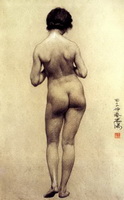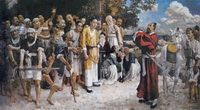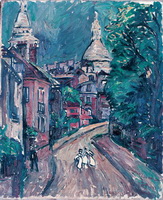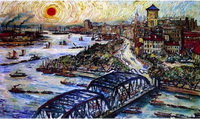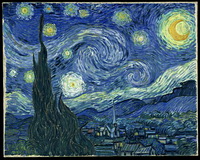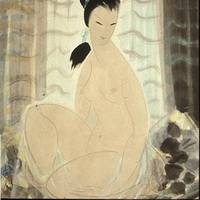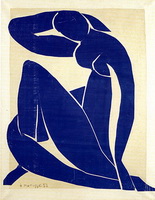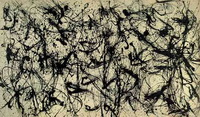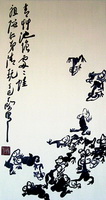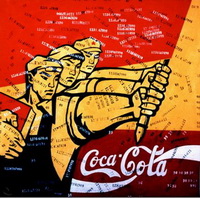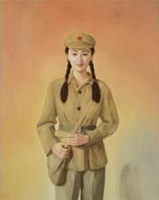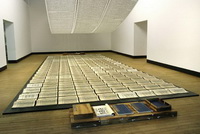In this essay I would like to discuss various theories, techniques and subjects of modern East Asian art. However, because both historical and political contexts are so relevant to the concept of much East Asian contemporary art, I fear I would not do the region justice if I were to categorize it so broadly and would thus like to focus more specifically on contemporary Chinese art.
Firstly, in order to fully answer the question posed, I would like to look closely at the definition of ‘modern’ in relation to art. It is generally agreed to define a set of cultural tendencies resulting from changes to Western society at the end of the 19th century, essentially a conscious change from the idea of ‘traditional’ art due to the social and political developments in a post-Industrial Revolution world. Therefore, is this a word that we can usefully apply to contemporary Chinese art? Does the meaning of the word ‘modern’ change when used in conjunction with a different society and set of cultural and political norms? Perhaps here the use of the word ‘modern’ is merely to distinguish from the sense of ‘traditional’. We could also look at it from a more rigid art-historical point of view in that ‘modern’ is the movement that precedes ‘postmodern’, thus suggesting the somewhat Orientalist view that East Asia is ‘behind’ us in the never-ending succession of new movements. I believe all of these options must be considered if we are to really appreciate the ‘modern’ style of contemporary East Asian art.
Let us start with perhaps the most simple interpretation of ‘modern’, the idea of new artistic styles and techniques due to the complete upheaval of society in terms of urbanisation and industrialisation. Is it unarguable that the East Asian artists of the 20th century took inspiration from the West in the way they responded to the ‘modern experience’; many intellectuals believed that Chinese culture and society was suffering and characteristically sought inspiration from the West. Artists such as Xu Beihong and Kang Youwei believed that interaction with the more ‘reality-oriented art’ of Europe would give Chinese painting a much-needed renaissance.
Xu Beihong decided to travel to Paris in order to learn what was, by Western terms, a very traditional set of skills such as the ability to draw with realistic representation, particularly the study of the human form (see image 1) which was not found at all in Chinese art; meanwhile, post-World War One Paris was bursting with what the West would call ‘modernist ideas’ but these were not of interest to the Chinese artist, demonstrating that the term ‘modern’ in an East Asian artistic context is extremely different from what we in the West believe it to mean. Xu then returned to China in order to apply this Western technique to Chinese subject matter, and painted ‘Tian Heng and his 500 Retainers’ (see image 2) which to our Western eye doesn’t look modern at all, if anything it appears almost Renaissance in its composition, dramatic posing of figures and use of colour scheme.
Xu may have learnt what we would call more ‘traditional’ techniques of Western drawing and painting, but Liu Haisu took this one step further and took his inspiration from what we would consider more ‘modern’: the Impressionists and Post-Impressionists. Not only did he revolutionise the teaching of art in China due to his foundation of the first school of fine arts in modern China, and through the use of nude models in the studio, he also wrote a book entitled ‘A Brief History of Western Landscape’, proving that he wasn’t merely copying a technique but understood the development of style in Western art.
His paintings ‘Sacred Heart Hospital in Paris’ (see image 3) and ‘Prosperous Shanghai’ (see image 4) are obviously influenced by Monet and Van Gogh respectively, the technique of brush stroke unquestionably borrowed from the Impressionists, particularly in ‘Prosperous Shanghai’ where the sun and sky are clearly a continuation from Van Gogh’s ‘The Starry Night’ (see image 5).
These artists may not be classified as contemporary but their breaking of boundaries was to set the scene for many more artists to come. Lin Fengmian painted his ‘Figure’ in 1980 (see image 6) whose flowing shape and emphasised outline is clearly a homage to Matisse’s ‘Blue Nude II’ (see image 7), while Wu Guanzhong’s ‘Revival’ (see image 8) looks even further forward to the American Abstract artists and could be quite easily mistaken for a Jackson Pollock (see image 9).
However, these examples are not meant to imply that Chinese art of the 20th century was merely derivative of earlier Western art periods; the artists mentioned, amongst many others, returned to China and would set up art schools and teach new techniques to new and budding Chinese artists, meaning that they had a chance to experiment with new visual techniques for the first time and were able to combine a more global style of art with a distinctly Chinese subject matter. The fusion between traditional Chinese art and these new techniques was to result in some fascinating paintings which will perfectly illustrate the second possible interpretation of ‘modern’ as the opposite to ‘tradition’.
In Chinese art this difference may seem subtle to our Western eye, once again emphasising the difference between our interpretation of ‘modern’ and theirs. Artists such as Ding Yanyong and Pan Tianshou pushed the boundaries of traditional Chinese illustrated calligraphy and ink painting, with the use of strong brushstrokes and bold compositions and the emergence of diagonal line. Perhaps the most revolutionary aspect of the Chinese ink painting was that it had a strong sense of the painted surface and was extremely aware of its own 2D quality, whereas Western art had aspired for realism in its visual representation right up until the invention of the camera that meant that artists had to seek other ways to depict their subject matter (for who could paint better than a photograph?) While it took the West until the 20th century to come full circle and return to the style of painting that rendered the viewer aware that they were looking at a flat surface, the Chinese artists had been doing this for centuries and so could be considered more ‘advanced’ conceptually than the West even though for them the ‘flat’ style of painting was considered ‘traditional’, meaning that the Chinese were either extremely modern in their thinking or extremely traditional, depending on how you look at it.
To return to the artists mentioned, Ding Yanyong’s paintings were unusual when held against a backdrop of ‘traditional’ Chinese ink painting due to their lack of landscape as the subject matter (see image 10). However, according to the Assistant Curator of an exhibition of Yanyong’s work at the Hong Kong Museum of Art, ‘he used the same technique and concept of Chinese calligraphy and literati painting, and also made use of the power of the brush stroke, and the monotone of ink wash’ so the technique changed very little yet at the same time he was modernising the subject matter.
The Assistant Curator also suggests that the images Yanyong depicts are like ‘a form of cursive script’ or a ‘very free hand doing traditional ink painting’, so to our naive Western eyes it may seem like just another Chinese ink painting, but in the eyes of the Chinese Yanyong’s paintings are playfully ground-breaking and can surely be considered modern (see image 11). Pan Tianshou similarly pushed new boundaries in the structure and composition of Chinese painting, and his works are full of inspiration and ‘modern senses’, using the emphasis of line to its full potential within a ‘traditional’ wall-hanging layout (see image 12).
One could say that this was the Chinese version of our western concept of ‘Expressionism’, whereby the artists are using their own personal reaction to their subject matter to influence the representation on paper.
Though these artists are technically ‘contemporary’ if we take the general museum definition of ‘contemporary’ art to mean art produced since the era of World War Two, they are mostly active before the second half of the 20th century, and anyway the definition of ‘contemporary’ is one again a Western construction based on a Western timescale. Let us turn our attention, then, to the political upheaval of the Cultural Chinese Revolution, which affected Chinese art on a similar scale that the 2nd World War affected the art produced in the West. The Chinese Cultural Revolution is a pivotal moment in 20th Century Chinese art as it resulted in an uncompromising change in society and politics and thus, inevitably, art.
Like the Industrial Revolution and the inevitable ‘urbanisation’ of the Western world that lead to our understanding of ‘modern’, the Chinese Cultural Revolution (hereby referred to as the CCR) affected the East Asian art world. The pivotal moment of change could be considered as Chairman Mao Zadong’s ‘Talk at the Yan’an Forum on Literature and Art’ in 1942, in which he called for a mass modernisation, and emphasized the need for literature and art to ‘reach a wider audience’ so that it could serve the public with a communal political interest. He was very anti-elitist, and determined to raise standards in order to ‘elevate the masses’. This was part of his greater plan in which he sought to ‘modernise’ China in all senses of the word, meaning that much of the traditional Chinese culture was destroyed, as were works of art from the Ming and Qing dynasty.
Mao wanted to create a ‘new visual culture’ in order to communicate the government’s goals and ideology to the people. This meant that artists were encouraged to paint images that ‘reflected the revolutionary spirit of the time’ and ‘create art for the people’. In terms of technique, this meant abandoning completely the tradition of ink painting that had been in practice for over a thousand years, and employing a ‘socialist realist’ style, and the subject matter, originally animal and landscapes, was replaced with workers, peasants, soldiers and, most importantly, Chairman Mao. Artists that refused to comply or continued to adopt more traditional methods or subjects were often imprisoned or tortured, with their art and land seized. Thus, the predominant style that ended up emerging from the CCR was a form of idealised realism, much like that in Communist Russia.
The CCR also came to highlight the importance of the written word and figurative icons; these became Chairman Mao’s visual legacies as ‘icons’ of the CCR. Here, then, the sense of modern was in the adoption of the Chinese words to create a sort of ‘anti-writing’, whereby the artistic sense involved in the writing overshadows what is in fact being written, rendering the words useless. Yet this word ‘anti-writing’ is a positive word in China, being that one is able to change literary words into images and by removing the value of the written word one can ‘emphasize the aesthetic value of the brushwork’.
There was also the political idealisation of Mao, with his identity not as mere man but almost as a god, represented by a red sun and fabricated by the revolution. His portrait was to become the most commonly painted subject; it is believed that during the CCR over 2.2 billion portraits of him were painted. After the CCR was over, it took years before any artist dared to ‘violate’ the image of Chairman Mao, but after one critical sculpture by Wang Keping called ‘Idol’ (see image 13), the floodgates opened, and he was followed by artists such as Wang Guangyi, who’s triptych ‘Mao AO’ (see image 14) is one of the most controversial Chinese paintings in recent history. Featuring three almost-identical prints of Mao overlaid with thick black bars, it gives the impression that he is imprisoned, and there is an irremovable barrier between his almost holy image and the revering public.
The critic Wu Hung believed that Wang Guangyi wanted to ‘liberate the visual image from its political and cultural identity’ and suggested that the ‘multiplicity of the copies destroys the singularity of a sacred icon... what he intended to achieve was to get rid of the ideology associated with the portrait, thereby reinstalling its status as a sheer image’.
Art that followed as a cultural response to the aftermath of the CCR is both intelligent and bitter. Wang Guangyi went on to pioneer a Chinese Pop Art movement which is popular even to this day; an example being ‘Coca-Cola’ from his ‘Great Castigation Series’ (see image 15), which is a bitter commentary on the communist worker style of portrait popular in the CCR and the rise of globalisation, which he feels is contributing to the loss of China’s past culture.
Another example is Post-Pop artist Qi Zhilong, who painted iconic portraits of female soldiers (see image 16) from the CCR period, using their green uniform as an emblem of ideology in order to make a comment on what it stood for; justice, sacrifice and righteousness. His realistic portraits are haunting and beautiful, and featured in an exhibition called ‘7 Characters; New Art from China’ that ran in 2007 at the Mayor Gallery in Cork St, London.
As for the most recent contemporary art, some Chinese artists have embraced more conceptual styles, resulting in works such as Xu Bing’s performance piece of 2002: ‘Golden Apples as Gift of Tender Sentiments’. He uses memories of ‘socialist tender sentiments’ of a generation as the ‘inspiration for building an art form and language’. He is also the artist behind one of the most famous pieces of Chinese Contemporary art: ‘Book from the Heaven’ (see image 17).
He explains in the exhibition catalogue of ‘Fengzhou; Contemporary Art Exhibition’ (held in Hong Kong in 2004) that ‘the cultural nutrition and experience constituents of my generation lie not in traditional culture, but the socialist culture or the culture of the Cultural Revolution. Though the Cultural Revolution is gone, its influences can be reflected at a deeper level. Work reflects an artist like a mirror. My works have aroused my recognition about the significance of the relationship between the Cultural Revolution and contemporary Chinese culture, as well as our need to positively envisage this cultural background and its integration into the construction of the macro-culture of the future.’ On the surface not all contemporary Chinese art works are necessarily seen to be political, yet their influence can be traced straight back to the aftermath of the Chinese Cultural Revolution; even today it resonates within the conception of Chinese art.
To conclude, then, contemporary Chinese art is something that must be examined within its own political and social constructs; we cannot apply our own definition of ‘modern’ without acknowledging the fundamentally Orientalist tendencies that it encourages. Instead, we can appreciate contemporary Chinese art in the way it has developed since the early 20th Century, and by realising that although the stylistic techniques and mediums are different from our own, they have undergone a modernization in their own way, even if it is difficult to recognise in our Western eye. From the early steps towards figural representation and the progression of ink painting into almost abstract forms, the modernisation of Chinese art has survived the Cultural Revolution and thrived ever since; the relative relaxation of political control following Mao’s death had a motivating effect on young artists to experiment with new media, new subjects and new methods of reaching the public eye, and so today the contemporary artists working in China can be considered equally as ‘modern’ as our own.
Bibliography:
- Clunas, C. ‘Art In China’, Oxford University Press 2009
- Clarke, D. ‘Images of Asia — Modern Chinese Art’, Oxford University Press 2000
- Jirhonh, J. ‘Burden or Legacy; From the Chinese Cultural Revolution to Contemporary Art’, Hong Kong University Press 2007
- Various. ‘Fengzhou; Contemporary Art Exhibition Catalogue’, held in Hong Kong 2004
- Various. ‘7 Characters Exhibition Catalogue’, held at the Mayor Gallery, London 2007
Image References:
- Image 1 – Xu Beihong, ‘Back View of a Female Nude’, 1924
- Image 2 – Xu Beihong, ‘Tian Heng and his 500 Retainers’, 1928-30
- Image 3 – Liu Haisu, ‘Sacred Heart Hospital in Paris’, date unknown
- Image 4 - Liu Haisu, ‘Prosperous Shanghai’, 1964
- Image 5 – Vincent Van Gogh, ‘The Starry Night’, 1889
- Image 6 - Lin Fengmian, ‘Figure’, 1980
- Image 7 - Henri Matisse, ‘Blue Nude II’, 1952
- Image 8 - Wu Guanzhong, ‘Revival’, date unknown
- Image 9 - Jackson Pollock, ‘Number 32’, 1950
- Image 10 – Ding Yanyong, ‘Untitled’, date unknown
- Image 11 - Ding Yanyong, ‘Untitled’, date unknown
- Image 12 - Pan Tianshou, ‘Magic fungus’, date unknown
- Image 13 - Wang Keping, ‘Idol’, 1979
- Image 14 – Wang Guangyi, ‘Mao AO’, 1988
- Image 15 – Wang Guangyi, ‘Great Castigation Series: Coca-Cola’, 1993
- Image 16 - Qi Zhilong, ‘Orange – Young Intellectuals’, date unknown
- Image 17 – Xu Bing, ‘Book from the Heaven’, 1987-91
© Caroline F. Ward, 2010

